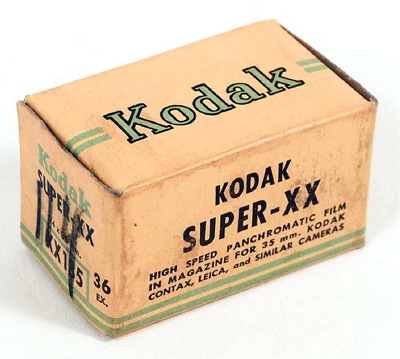 [Editor’s Note: Combat veteran and amateur military historian Charles Herrick’s crucial earlier posts in this series corrected 70 years’ worth of miscaptioning of one of Robert Capa’s ten D-Day photographs from Omaha Beach, and pinpointed the exact location and approximate time at which he landed on the Easy Red sector with a later wave.
[Editor’s Note: Combat veteran and amateur military historian Charles Herrick’s crucial earlier posts in this series corrected 70 years’ worth of miscaptioning of one of Robert Capa’s ten D-Day photographs from Omaha Beach, and pinpointed the exact location and approximate time at which he landed on the Easy Red sector with a later wave.
In this new article, Herrick, at my request, performs a deep dive into the military records in order to “follow the film” — that is, to detail the logistical steps through which Capa’s D-Day exposures moved through the system from the moment Capa re-boarded the USS Samuel Chase after leaving Easy Red until the moment they got delivered to John Morris at LIFE‘s London office on the night of June 7, 1944.
Bits and pieces of the journey these films made have appeared in previous posts by Herrick and myself, but never connected as a coherent narrative. We believe that tracking them all the way from the beach to Morris’s hands sheds considerable new light on the situation, and on the myth.
Part 2 appears below; click here for Part 1; click here for Part 3. — A. D. C.]
•
Follow the Film (continued)
by Charles Herrick
… Once Robert Capa returned to the USS Samuel Chase from Omaha Beach, re-crossed the English Channel, and landed back in England (see previous post), the next step toward the eventual delivery of his D-Day film was its transport to London. This was accomplished by means of the Dispatch Rider Letter Service — a team of motorcycle couriers who ran regularly scheduled trips with material collected by the press-relations officers in Weymouth. It’s likely that Capa’s film had to wait some time for the next run, and this would have further delayed his film.
From this point on, we must rely heavily on LIFE assistant picture editor John Morris for details, and Morris proved himself a not especially reliable source. He originally claimed that at 1800 hours the bureau received word that Capa’s film shipment was on the way to London[1]; years later this slipped back to 1830 hours.[2] Part of the delay in notifying him can be chalked up to the press-relations officers waiting for the next available dispatch rider, and part to the difficulty of getting a call through from Weymouth to London on the overloaded phone circuits that evening.
Numbers
Let’s pause for a moment to review what film Capa sent off to London when he landed in Weymouth. Morris’s multiple recountings of the Capa saga varied significantly over the decades, so let’s turn to the evidence of the film instead. Before he became incommunicado aboard the USS Samuel Chase, waiting for the Channel crossing, Capa had sent back to London two rolls of 120 film and one of 35mm film documenting the embarkation at Weymouth. We know that, since captioned photos matching his caption-note sheets for those rolls were cleared for release by London censors on D-Day, June 6, while he was on the Normandy coast. So these three rolls could not have been in his post-D-Day 7 June packet to London.
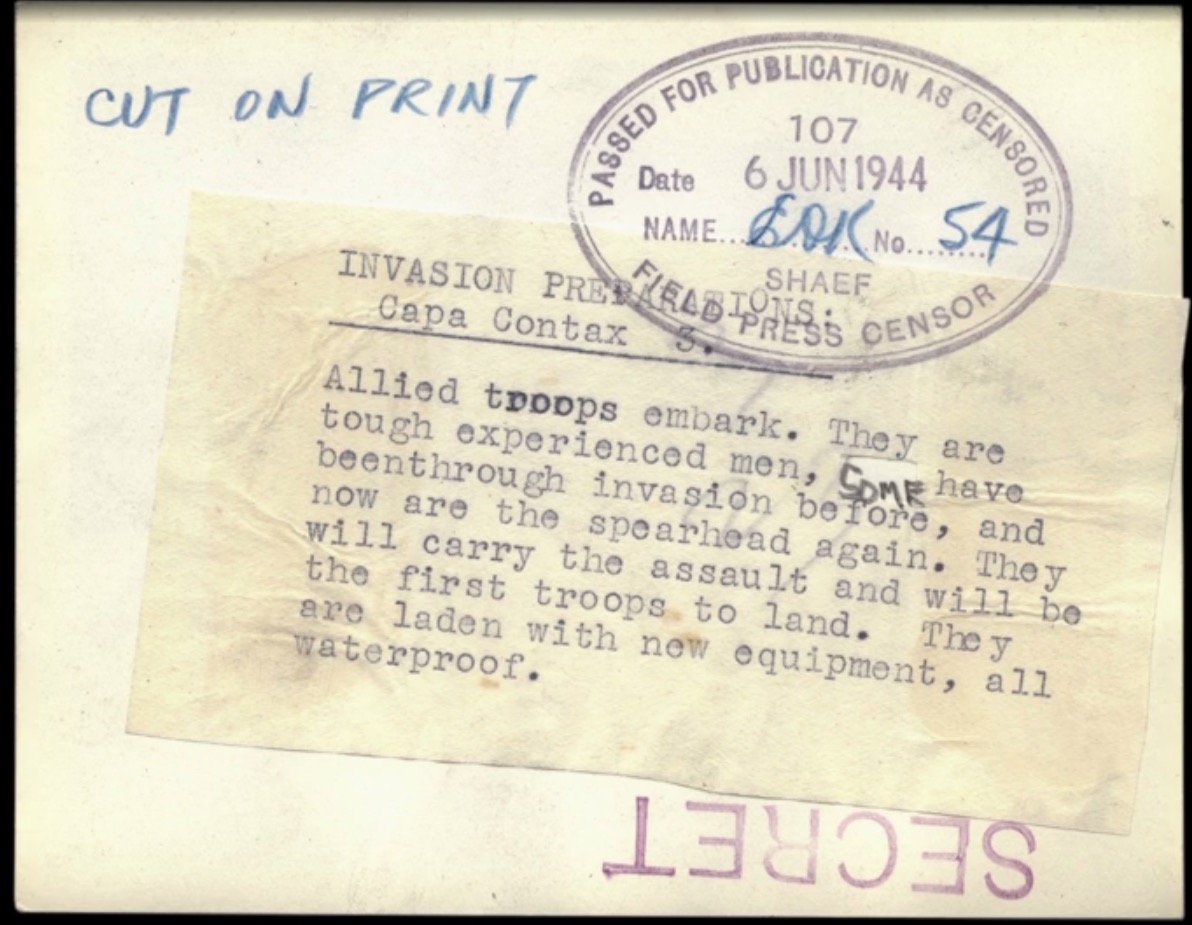
Robert Capa, untitled (troops boarding at Weymouth for D-Day), verso with caption and SHAEF stamp dated 6-6-44, screenshot from TIME video
•
•
Starting from the time he was locked down aboard the Chase, any film Capa exposed had to wait until his return to the UK before it could be dispatched to London. From the materials held by the Robert Capa and Cornell Capa Archives at the International Center of Photography (ICP) in New York, we know that this would have included one roll of 35mm taken of troops playing cards and sunning themselves before the Chase sailed. (Figure 3).
Then there was a second 35mm roll exposed as the ship was leaving for the invasion — the “Last Glimpse of England” pictures. (Figure 4. That’s what Capa wrote in pencil on the subject line of his caption notes for this roll.)
Two 35mm rolls showed the mission briefing around the terrain model of the Normandy coast set up in the Chase‘s gym, which took place the night of the Channel crossing. (Figure 5)
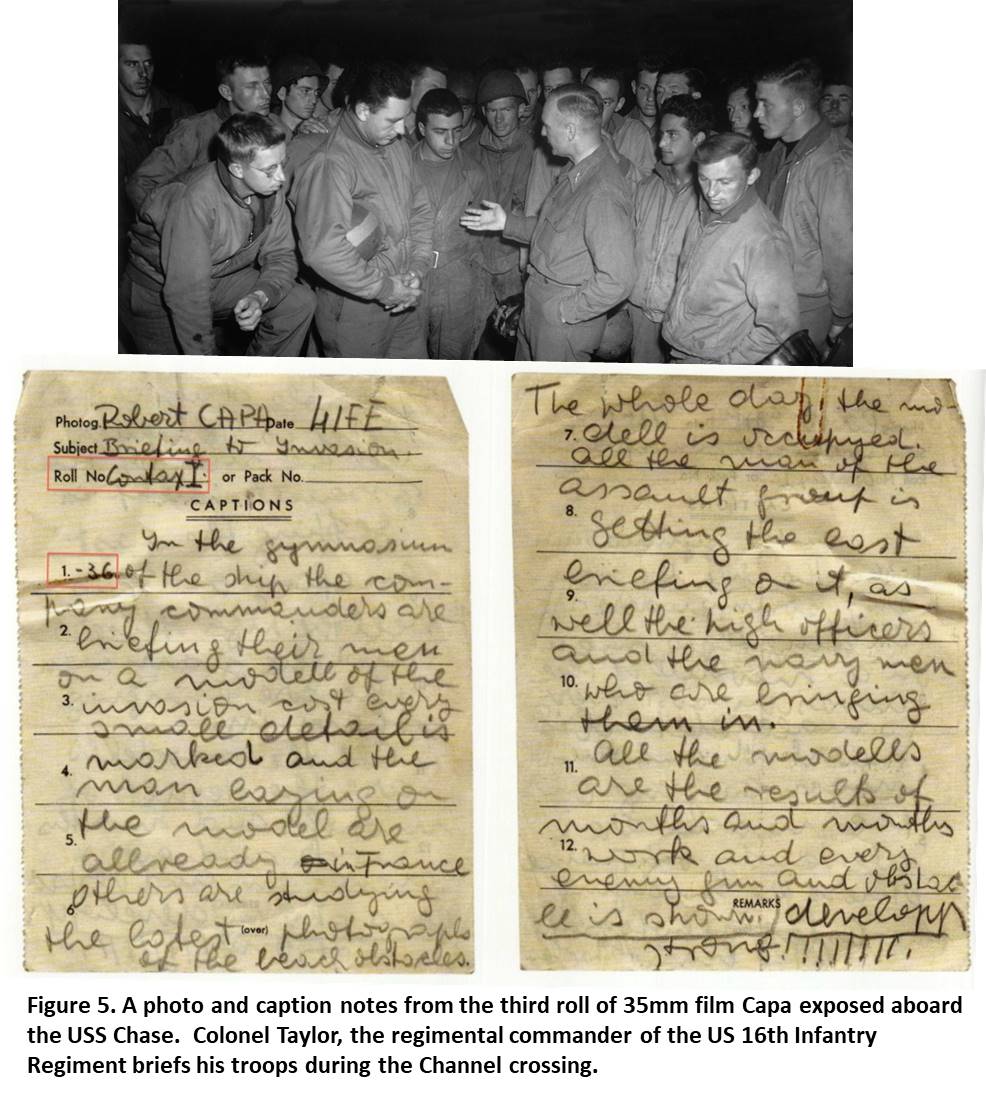 In the ICP archives A. D. Coleman discovered portions of two different 35mm rolls that Capa devoted to this briefing. Additionally, he found five images of the briefing on 120 film, suggesting that Capa made at least one roll in this format covering the event. Finally, Coleman also found five negatives in the ICP archives taken that same night, depicting the same briefing — negatives that match the film format of a Speed Graphic camera. No separate caption sheet appears to exist for those 120 and 4×5 pictures of the briefing, and the photos do not seem to have been published at the time. [Editor’s note: The heavy, cumbersome 4×5″ Speed Graphic, then a common tool for press photography, was standard issue for military photographers. Capa himself never carried one; presumably he borrowed one, and mooched a film pack, from a U.S. Signal Corps photographer on board the Chase. — A.D.C.] So that totals four rolls of 35mm film, one of 120 film, and some 4×5 film exposed by Capa aboard the Chase on June 4-5, before the landings.
In the ICP archives A. D. Coleman discovered portions of two different 35mm rolls that Capa devoted to this briefing. Additionally, he found five images of the briefing on 120 film, suggesting that Capa made at least one roll in this format covering the event. Finally, Coleman also found five negatives in the ICP archives taken that same night, depicting the same briefing — negatives that match the film format of a Speed Graphic camera. No separate caption sheet appears to exist for those 120 and 4×5 pictures of the briefing, and the photos do not seem to have been published at the time. [Editor’s note: The heavy, cumbersome 4×5″ Speed Graphic, then a common tool for press photography, was standard issue for military photographers. Capa himself never carried one; presumably he borrowed one, and mooched a film pack, from a U.S. Signal Corps photographer on board the Chase. — A.D.C.] So that totals four rolls of 35mm film, one of 120 film, and some 4×5 film exposed by Capa aboard the Chase on June 4-5, before the landings.
It is more difficult to pin down Capa’s D-Day film tally, and a discussion of the various theories is far beyond the scope of this post. In Slightly Out of Focus, Capa mentions taking out one 35mm Contax II camera as his landing craft approached the beach, and then swapping it for his second 35mm Contax camera while at the “shingle” embankment on the dry edge of the beach. According to this account, he finished the roll of film in each camera, then ruined another roll trying to change film under fire. However, no evidence supports either his claim to have reached the shingle or the assertion that he used his backup Contax at all during his brief stay on Omaha Beach. Thus we have actual evidence of only one roll of 35mm film exposed on the beach.
After boarding LCI(L)-94, Capa wrote, he changed film in both his cameras — clearly referring to the two Contax cameras — and went back above decks to take more pictures.
[Editor’s note: It would be standard procedure, once Capa got himself dry, to take any fully exposed rolls out of his Contax camera(s) and put them in his waterproof pouch, and then immediately reload, to have them at the ready. As a rule, photographers don’t carry around unloaded cameras.
All the Capa negatives we have from LCI(L)-94 and back aboard the Chase are 2-1/4″, a strong indication that he switched to his Rolleiflex for the rest of the trip. Because editors preferred the larger-format 2-1/4″ negatives from the Rolleiflex (more data encoded, less grain upon enlargement), Capa and others often used the bulkier, less versatile twin-lens reflex when the action was slower-paced and available light, subject matter, and other conditions allowed. — A.D.C.]
There are no surviving caption-note pages for any of Capa’s D-Day film. So, based on the evidence at hand, the film packet he delivered to the press message center in Weymouth should have included five rolls of 35mm film, two (and most likely more) rolls of 120 film, and an unknown quantity of 4×5″ sheet-film negatives. [Editor’s note: probably no more than a standard 10-pack’s worth of the 4x5s. — A.D.C.]
Unfortunately, John Morris only added confusion to the issue. In his Jozefa Stuart interview, recorded more than 50 years ago (lodged in the International Center of Photography’s Robert Capa and Cornell Capa Archives), he claimed he received just two rolls of 35mm and four of 120. Years later, this tally had grown to four rolls of 35mm and six of 120. Further, Morris flip-flopped on the question of whether these tallies included the shipment that was actually sent in prior to Capa boarding the Chase in Weymouth, before the armada sailed.
Whatever the true count, according to Morris a brief note from Capa that accompanied the film supposedly alerted him that “all the action was in the 35mm.” [Editor’s note: Such a note would have proved entirely unnecessary, since Capa never used his 120 Rolleiflex in combat situations, as Morris well knew. If this note indeed ever existed, it has long since vanished. — A.D.C.]
The Censor’s Red Pen
At this juncture in Morris’s various tellings of the film’s saga, he has omitted entirely a vital matter, that of censorship by the Supreme Headquarters Allied Expeditionary Forces (SHAEF). Recall that any undeveloped film coming in from correspondents at the front was assumed, as a minimum, to merit classication as secret material, so the handling of Capa’s film would both begin and end on the censors’ desk.
Yet Morris was dismissive of the issue. In one of his anecdotes about censorship encounters, Morris simply glosses over the censorship issue, implying that there were only a couple of taboo subjects and that “his” photographers — he often used that proprietary locution, though he had no actual authority over any of them — were experienced enough not to capture anything that would require the censor’s red pen. In another, his only mention of any post-D-Day censorial attention to Capa’s images, the SHAEF censor is little more than a buffoon who cannot manage to use a roll of adhesive tape.
The reality was much different. Censorship was an essential part of the process, and there was far more to worry about than Morris implied. In fact, the SHAEF censors’ “Bible” — its protocols and instructions — would grow to 200 mimeographed pages covering a broad range of subjects (Figure 6),[3] and we know that at least one of Capa’s surviving photos from the USS Chase ran afoul of that process. (See Figure 3, top right photo. The censor’s red ink on the proof indicates that the film was rejected by the censor until sensitive elements in the negative and any prints made therefrom were obscured.)
When Capa’s film arrived in London, it landed immediately not at LIFE‘s London office — as all of Morris’s accounts have implied — but at the message center of the Ministry of Information, a division of SHAEF. There a SHAEF Public Relations officer would have made a preliminary examination of the caption notes, and, based on that, could have chosen to modify the preliminary classification of the film. If the caption notes showed no indication of any top-secret material, the film would retain its presumptive secret classification and get sent to the appropriate news-bureau lab — LIFE‘s darkroom, in this case — for developing and proof-printing, then get returned to the censors for final review and classification. Whatever they approved could thereafter get used for publication; anything they disapproved they would confiscate.
But if the caption notes indicated that any top-secret material might be on the film, it was a much different story. The film might still get sent to the news-bureau lab for developing, but only under the strict control of a SHAEF officer who would closely monitor the developing process and the making of contact sheets and prints, then personally take all products — negatives and prints — back to the censors, without anyone at the news bureau save the lab staff ever seeing the images. Alternatively, the film could be sent to a military lab for processing.[4]
•
Our problem is that none of Capa’s caption notes for his D-Day images have survived — assuming they ever existed.[5] As a result, we don’t know what if anything the censor read about the subject matter of those negatives, how it might have affected the classification determination, and how Capa’s film would have been handled. And we probably never will. But it is relevant to recall that Capa had been at the heart of the major security fiasco of 1942 in the UK.
While covering the 301st Bomber Group, Capa inadvertently made an image that included the top-secret U.S. Norden bomb sight. For whatever reason, he failed to pass his film by a U.S. censor at the air base. Instead, he dropped his film off with his editor in London, who, stuck with uncensored film, passed it by a convenient censor. Unfortunately, that censor was not U.S. Army Air Force but Royal Air Force (RAF), and unaware of the Norden’s top-secret status.
The picture had been printed on the cover of 400,000 copies of London-based Illustrated magazine’s 5 December 1942 issue before the error was caught. Illustrated had to destroy all 400,000 copies, at what must have been some considerable cost.[6]
And although Capa escaped formal censure in the ensuing inquest, and tried to later pass it off as a humorous incident in his biography, it delayed his accreditation for months.[7] One can only imagine how badly this damaged his reputation among the members of the censorship community — and bureaucracies have long memories. So it is virtually certain that when his film from D-Day arrived the censors gave it close scrutiny.
Nor was Morris’s stock likely to have been much higher among the censors. According to his 1998 memoir Get the Picture, some time before D-Day Morris somehow obtained photos that had come into London from Stockholm via diplomatic pouch, depicting bomb damage from Allied attacks on Germany. The pictures showed in graphic detail the devastation in Berlin. Although Morris claimed he knew “full well how slim were my chances of getting these pictures on the plane to New York,” he nevertheless tried to get them passed by a censor — testing the limits, and effectively asking for trouble. Not surprisingly, the entire lot got confiscated.[8] While Morris tried to pass off the incident as something of a fraternity prank and a topic for laughter at the Dorchester Hotel bar (the popular press hangout in London), the incident showed surprisingly poor judgment on the part of a man representing a major U.S. news organization’s London photo division.
As a result of these two incidents, it seems inevitable that any packet tied to Morris’s office — whether addressed to him or submitted by him — and containing film from Capa would receive extremely close examination from the SHAEF censors. …
•
Notes:
[1] Jozefa Stuart’s manuscript and interview notes are held by the International Center for Photography and were kindly made available to the author. [Editor’s note: In the early 1960s Cornell Capa commissioned Jozefa Stuart to conduct a series of interviews, apparently toward a biography of Robert Capa that never materialized. — A.D.C.]
[2] John Morris, Get The Picture, p. 6. After his book was published in 1998, his revised times became widely circulated in secondary coverage of the Capa saga.
[3] Forrest C. Pogue, The Supreme Command, p. 91
[4] These procedures were specified in SHAEF Public Relations Division memo, Subj: Processing of Still Photographs from War Correspondents, dated June 1944.
[5] All we have is a postscript to a caption notes page for a pre-landings roll of film (the “Last Glimpse of England” notes, Figure 5) with the cryptic comment “Film like everything got wett by landing” (sic). This note was clearly written after the landings and may indicate that Capa’s remaining store of blank caption-note pages was ruined in the surf, and he had to resort to adding notes to a previously filled-out sheet. But it is also possible the censor confiscated Capa’s D-Day caption notes, based on perceived top-secret content.
[6] Robert Capa, Slightly Out of Focus, pp. 30-37.
[7] Richard Whelan, Robert Capa: A Biography, p. 184. Although in Slightly Out of Focus Capa said he was granted immediate accreditation before the inquest so they could court-martial him if found guilty, Whelan noted this was not true.
[8] Morris, Get The Picture, pp. 70-71.
•
Text copyright © 2019 by Charles Herrick. All rights reserved.
•
(For an index of links to all posts in this series, click here.)
•
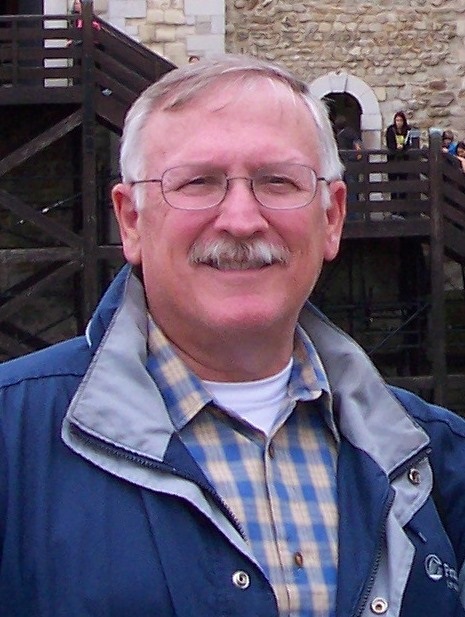 Charles Herrick joined the U.S. Army in 1970 and graduated from the U.S. Military Academy at West Point in 1974. Commissioned in the Infantry, he earned the Ranger tab and Master Parachutist’s wings. He served in a variety of positions from company grade officer to the Pentagon. He earned the Combat Infantryman’s badge while assigned as the Operations Officer of the 193rd Infantry Brigade in Panama in 1989, and later graduated from the U.S. Army War College.
Charles Herrick joined the U.S. Army in 1970 and graduated from the U.S. Military Academy at West Point in 1974. Commissioned in the Infantry, he earned the Ranger tab and Master Parachutist’s wings. He served in a variety of positions from company grade officer to the Pentagon. He earned the Combat Infantryman’s badge while assigned as the Operations Officer of the 193rd Infantry Brigade in Panama in 1989, and later graduated from the U.S. Army War College.
Since retiring from the Army in 1996, Herrick has continued to work on defense issues as a contractor in East Asia, Latin America, the Balkans, Africa and Central Asia. He holds an MBA from the University of California at Los Angeles. He lives in California with his wife, where he pursues his passion for military history. To contact Charles Herrick, click here.


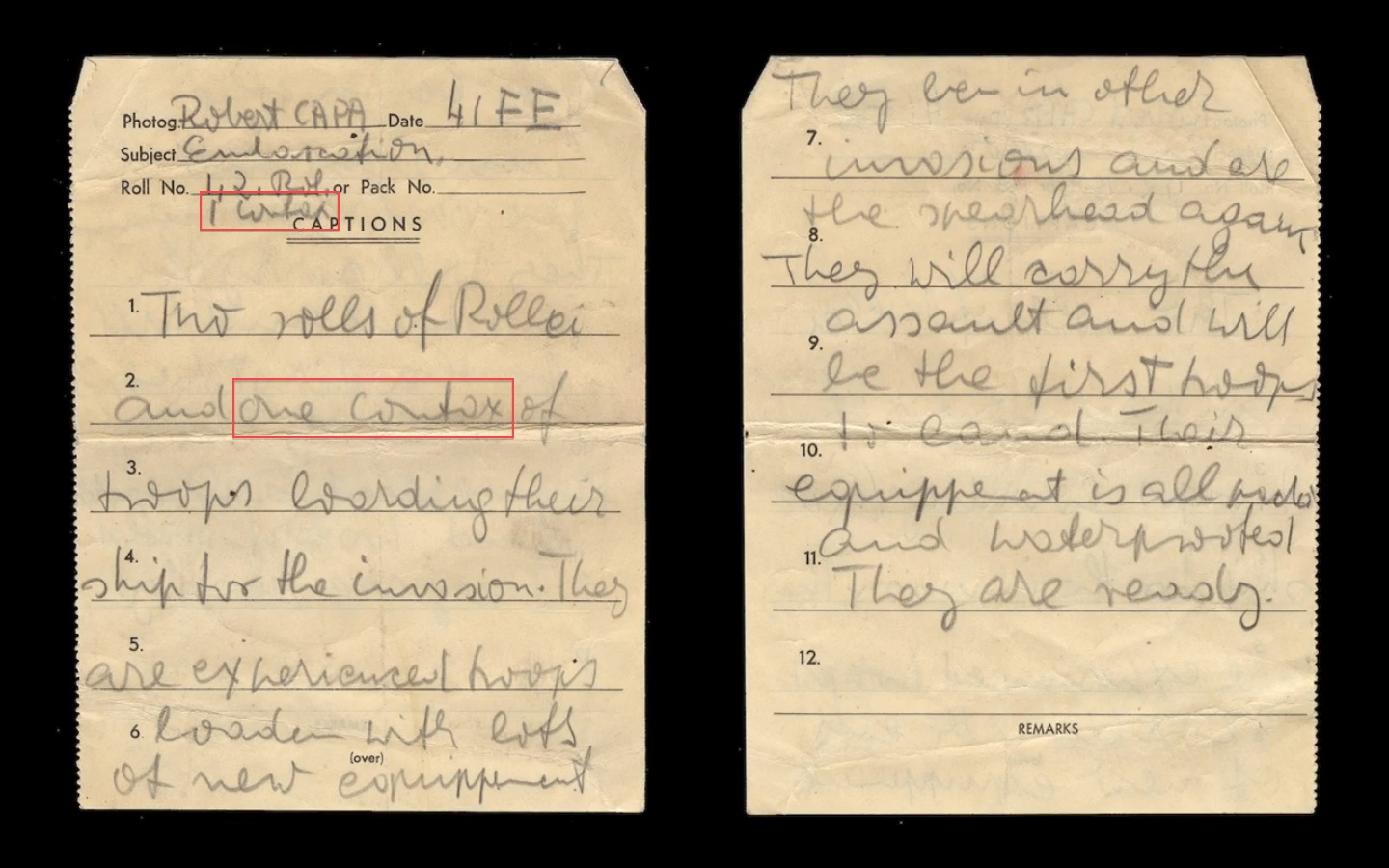
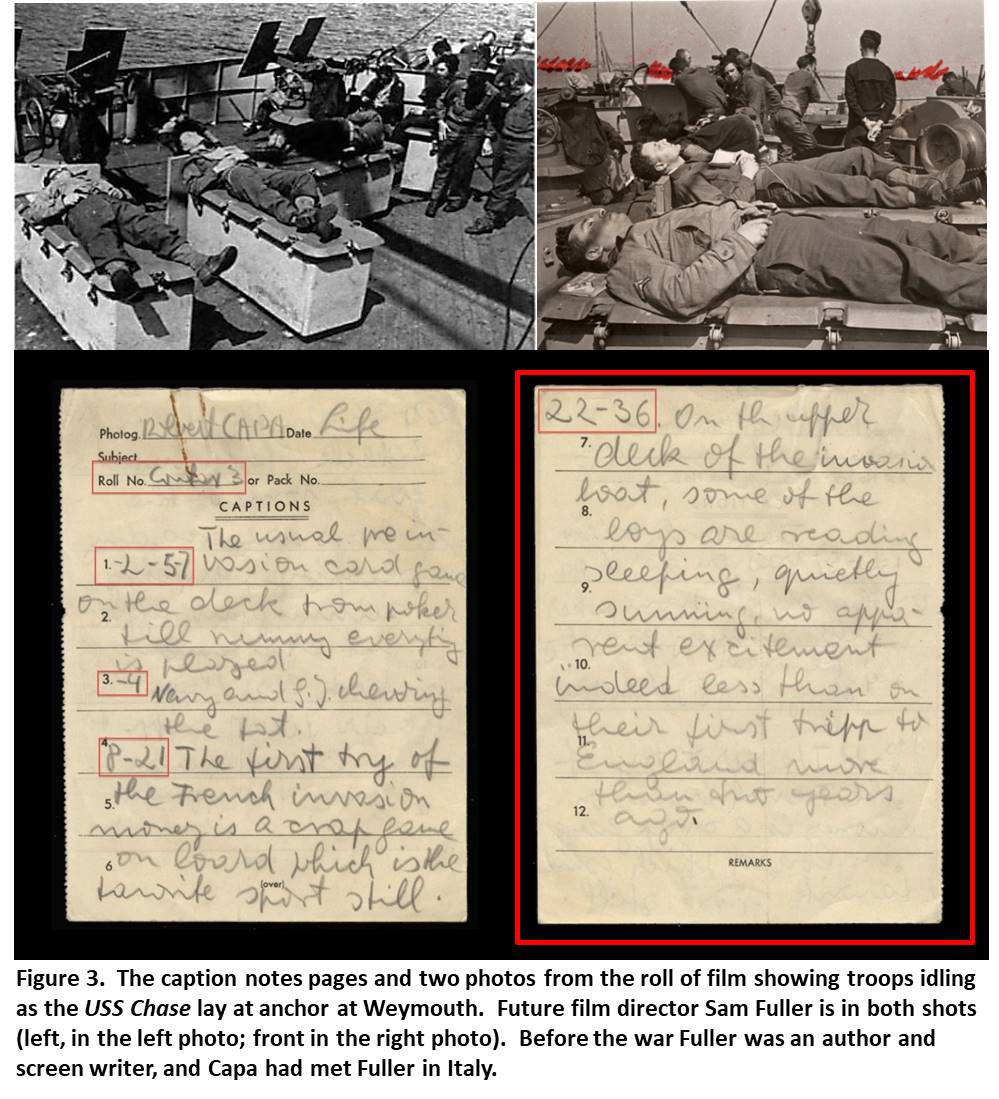
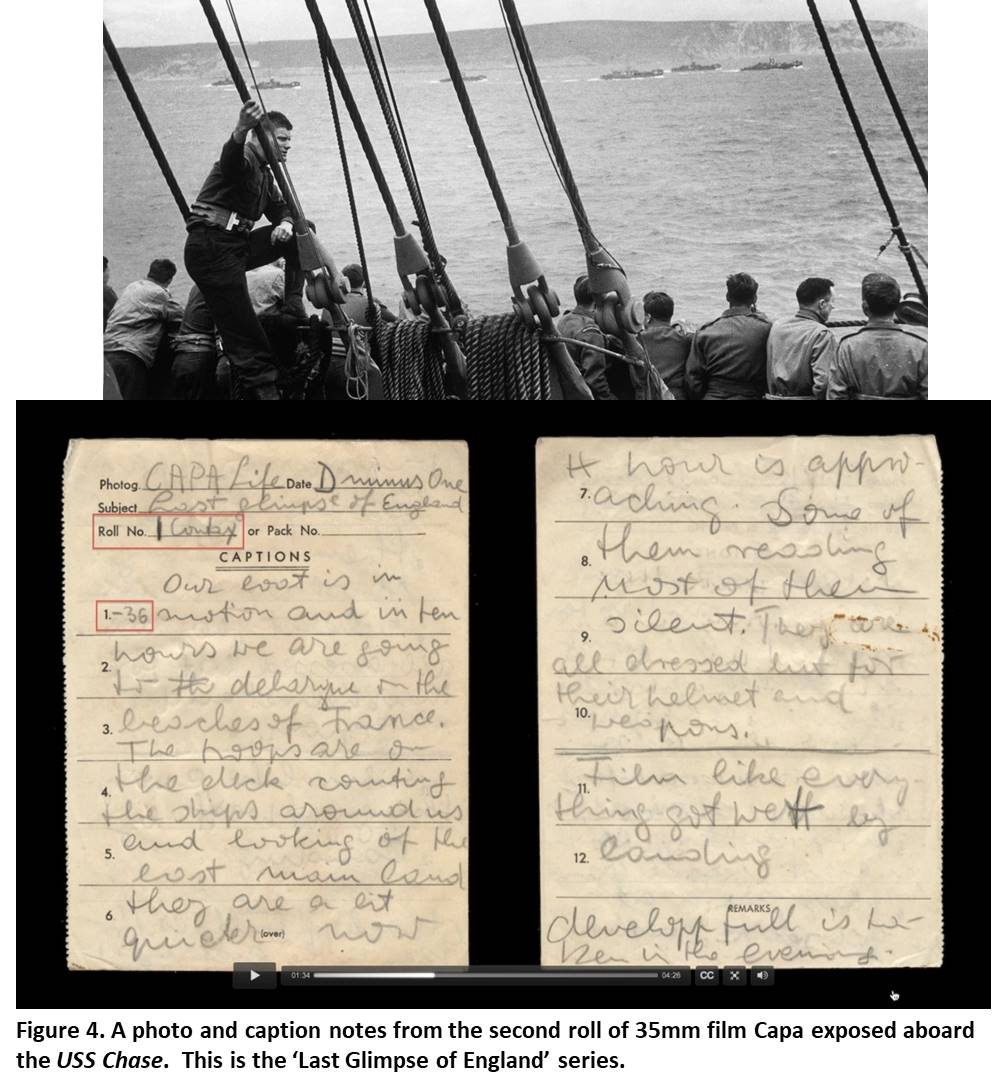
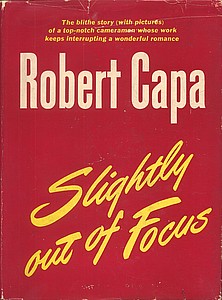
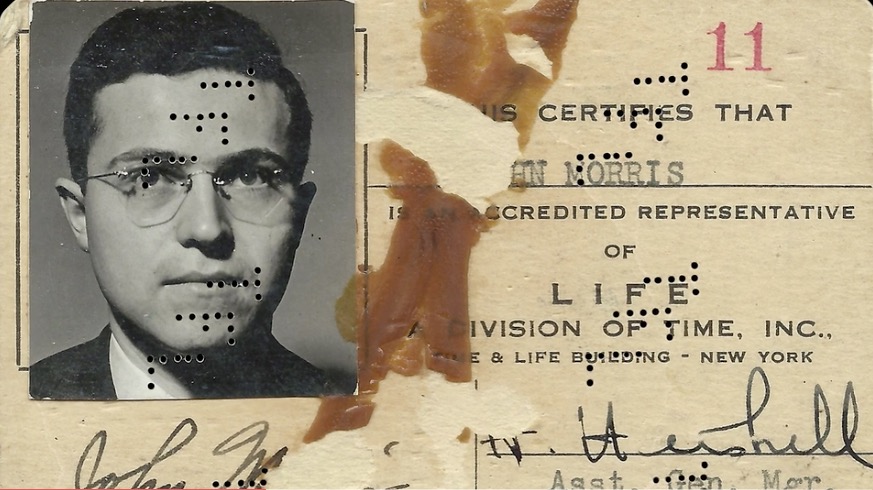
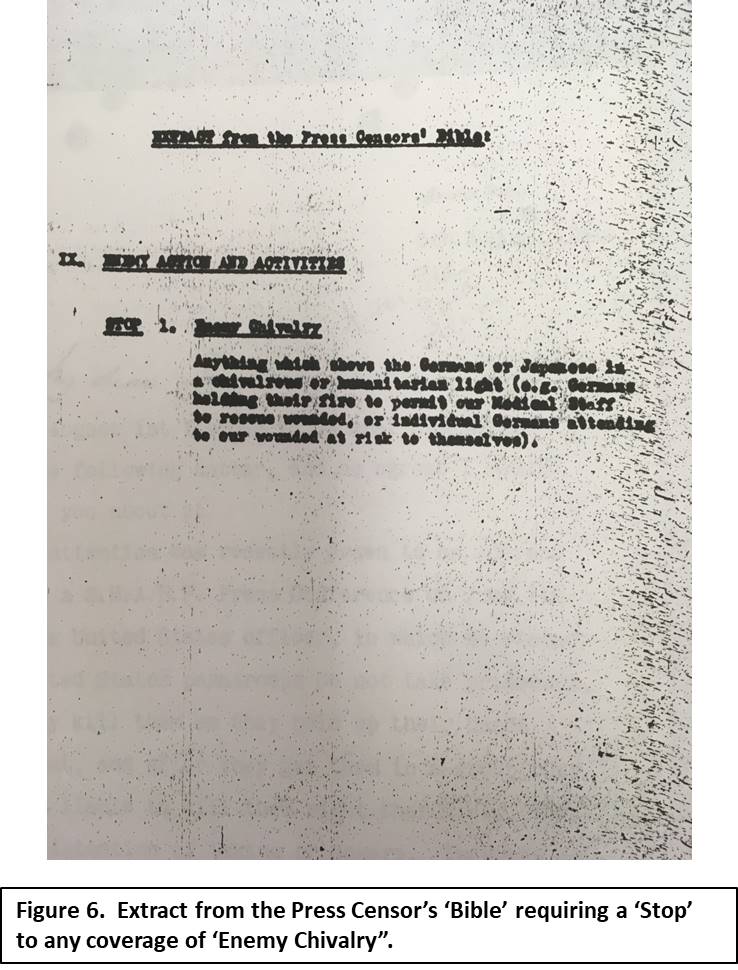
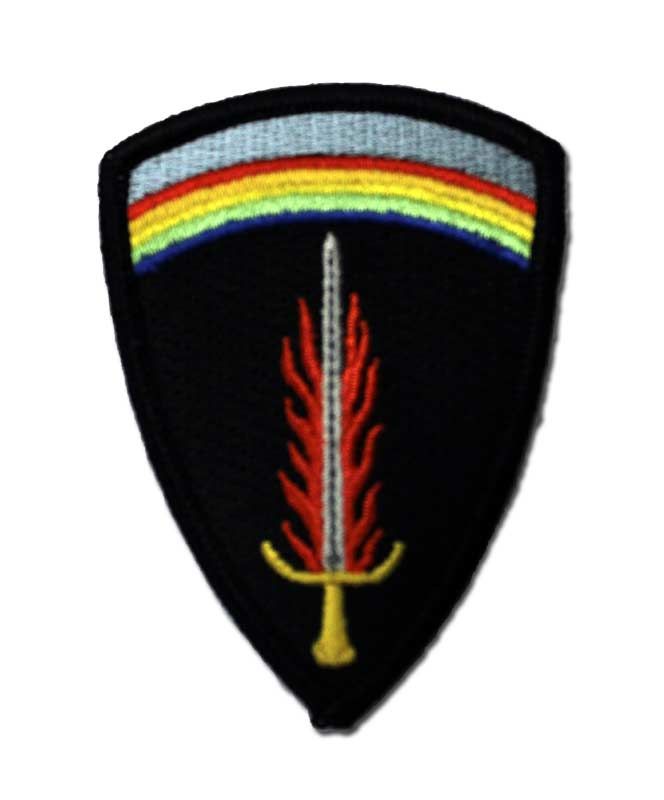
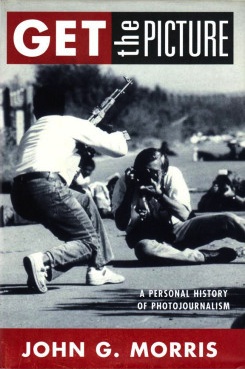




Another instance of astounding and detailed research by Mr. Herrick. These posts have greatly enriched our understanding beyond what any usual photo history might convey. There are obviously many layers here not considered before. Great job.
Stephen Perloff, Editor
The Photo Review
Thank you, sir. Your kind comments are greatly appreciated.
When I began contributing to this project I knew there was a good deal yet to be discovered, but it has grown far, far beyond anything I could have expected.
And a tip of my hat to Allan’s excellent editorial skills! He’s been the heart and soul of this project.
Chuck
Hello! As the daughter of LIFE photographer, Frank J Scherschel who roomed with John Morris in London and whom I met in 2016, this impressive research holds so much interest! It was a unique time in photojournalism history. Thank you for your diligence.
I suspect the whole story will never see the light of day anymore than will all the millions of images by many photographers – despite what even I say, as unwarranted focus on a few. Please keep up the great work to seek the facts.
Dear Ms. Scherschel:
Thanks for your good words about this project.
I would hope that someone, someday, will undertake a study of the entirety of LIFE’s D-Day coverage and reportage on the subsequent invasion, including your father’s. It’s a key moment in the history of photojournalism. In fact, I’ve been hoping that someone at LIFE will see fit to do just that as a celebration of the upcoming 80th anniversary. Sadly, the most logical candidate for that task — former LIFE staffer John Loengard, who became the semi-official historian of LIFE’s contribution to photojournalism — died in 2020, and to the best of my knowledge no one has succeeded him in that role.
Presumably, the raw materials for that project, including the results of Frank Scherschel’s D-Day assignment, reside in the LIFE archives at the New-York Historical Society.
Our team has bitten off just a chunk of that larger story, which, as you can see, is almost more than we can chew.
Your encouragement means a lot to us. Thanks again.